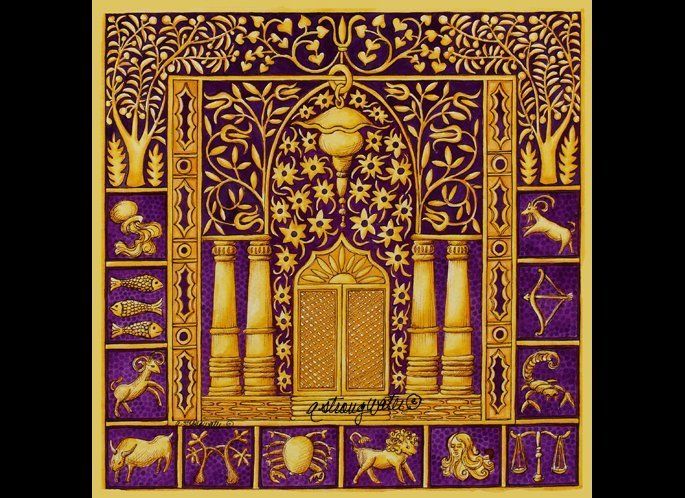How did I decide to re-create synagogues across Europe that were lost during the Third Reich and WWII?
About five years ago, my art licensing agent asked if I could create a Jewish calendar -- one using the standard western calendar with illustrations of Jewish holidays, rituals and symbols. It was a dream assignment for me. I have a collection of childhood memories that I channeled into this work and I made the paintings as vibrant, happy and untrammeled as my thoughts. I digitally photograph and save all my artwork so it can be printed on almost any surface. I'm still looking for a calendar publisher while the art has been successful in other forms -- ceramic tiles, notecards, chocolates (using edible ink and sugar paper), ketubot (marriage contracts), notecubes, giclee prints. I have also used some of them as illustrations in my book, "Where We Once Gathered -- Lost Synagogues of Europe."
The calendar art was the first Jewish art I had made since elementary school, and with its popularity buyers started coming to me for more Jewish art. I needed more than 12 images. I turned to my book shelves for inspiration and re-discovered a book I bought in 1980: "Images et Traditions Juives" by Gerard Sylvain, a collection of postcards from 1897-1917 of Jewish life from around the world. The postcards are fascinating but the ones of buildings require very careful scrutiny. I wanted to clarify them in new paintings and make the buildings more appealing to 21st century America. I painted four of the synagogues by pouring over details, trying to get exactly what the buildings looked like. I made educated guesses about the colors while factoring in my goal of making the viewer feel these buildings and want to be there. The constant in my work is to create beauty and I wanted these buildings to be seen at their most glorious.
I added the first four synagogue paintings to my website and asked my usual question, "Which paintings do you like the best?" Universally, it was the four synagogues. So I painted four more and the eight synagogues became everyone's favorites. People started asking questions about the buildings. Where were they? Who built them? When? What is there now? I used up the resources in "Images et Traditions Juives" and found small caches of old postcards at the Jewish Theological Seminary in New York and the U.S. Holocaust Memorial Museum in Washington, D.C. A Judaica collector gave me a CD with hundreds of photos of old synagogues. There wasn't much information connected to the postcards to define them. I spent time in the libraries of the Jewish Theological Seminary and Cornell University and found some reliable sources online to recreate the history behind each building. There were thousands of synagogues all across Europe, some destroyed, some put to other uses, some re-built, some tourist destinations, but I couldn't know that until I had identified each photo and researched the history. I couldn't possibly address them all. I decided to narrow down my project to only synagogues that were totally destroyed. Those are the ones that need my attention for without it they could be lost forever.
I sold postcards and notecards of my paintings and hoped -- and still hope -- that I am mimicking the process that made my work possible. The original postcards survived through wars and the holocaust landing in museums, archives and personal collections. People hang onto postcards. I felt that mine could extend the life of these buildings at least another hundred years. A museum asked if I had a booklet of the work and the idea of collecting it into a coffee table book came into focus. I decided to do a first volume with 80 synagoguesb leaving room for a second volume if things work out. The coffee table book will include my paintings, archival photos and a full text based on my research.
I hired a book producer to take my 120 paintings and text and turn them into a book proposal. I started knocking on doors to find a publisher. No one said they didn't like it. Many said they wished they could publish it or represent it but all but said they just couldn't see it working for them.
I spoke to everyone I knew and everyone I met about this project. I joined weekly networking groups, went to one-time events, joined the Council of American Jewish Museums, called everyone my brother or any acquaintance recommended and everyone each of those people recommended. I spoke to people who were helpful, not helpful, rude, caring, wanted me to do what they had in their mind, were moved by the project or not. I joined Linked In and every Linked In group that seemed to fit. And after two years of knocking on doors, I contacted Eifrig Publishing through a Linked In group. I hadn't thought about doing a children's book but it seemed worth a conversation. We turned out to be a perfect match and now, in addition to a coffee table book, most likely to be published in conjunction with a museum, there will be a series of five children's books appropriate for ages 8-10. The children's books are overwhelmingly visual with just enough text to give the reader a sense of European Jewish history. The first book will be available in hardcover in April.
I am still working on publishing a comprehensive coffee table book and a Jewish calendar, but I recognize that this series of children's books is part of the journey and a contribution to Jewish history. Being an artist means defining my own path and recognizing the next step even when it's not one I thought of in advance.
